| |
|
Charles
Butters on Sandino's return to San Albino Mine
in June 1927
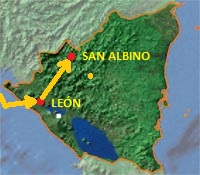 In mid-1926 Sandino returned from exile
in Mexico and journeyed from the city
of León
up to the San
Albino Mine in the northeastern Segovias, owned
by US citizen Charles Butters, where he got a
job as a pay clerk. In retrospect, his
decision to seek employment among politically
oppressed and economically exploited wage
workers in a mining enclave dominated by US capital could not have been
more shrewd.
In mid-1926 Sandino returned from exile
in Mexico and journeyed from the city
of León
up to the San
Albino Mine in the northeastern Segovias, owned
by US citizen Charles Butters, where he got a
job as a pay clerk. In retrospect, his
decision to seek employment among politically
oppressed and economically exploited wage
workers in a mining enclave dominated by US capital could not have been
more shrewd.
As the civil war
between Liberals and Conservatives heated up in
the summer and fall of 1926, Sandino organized
the nucleus of what later became his Defending
Army — which appears to have been his plan all
along. In late October 1926, Sandino and
the mine workers rose up in rebellion against
the Conservative regime dominated by Emiliano
Chamorro and Adolfo Díaz and their local
Segovian cronies. In early
November, Sandino's Liberal rebels attacked the
Conservative garrison at El Jícaro. Over the
next seven months, as civil war ravaged the
country, Sandino emerged as one of the top
Liberal generals, at one point commanding
upwards of 1,000 troops.
After 4 May
1927, the day that Liberal Commanding General
José María Moncada (at the behest of ousted
Liberal President Juan Bautista Sacasa) signed
the Espino Negro Accord (or Treaty of Tipitapa),
Sandino became the only Liberal general to
refuse to disarm. Instead he and a handful of
followers headed back up to San Albino Mine to
begin their rebellion against the vendepatria (country-seller) Moncada and the US
Marine intervention.
Thus Sandino's
rebellion against the US government's
"trampling underfoot" of Nicaraguan national
sovereignty began in the
same US-owned mining enclave where his uprising
against the Conservative Díaz
& Chamorro regime began eight months earlier.
Only now, the civil war between Liberals &
Conservatives was formally over, and the fight
against the Marines and Guardia Nacional was
about to begin.
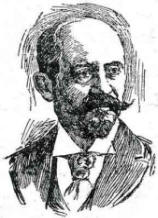 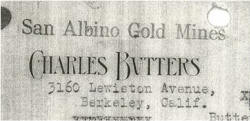 Charles Butters' narrative offers a
remarkable description of Sandino's return to
San Albino and portrait of his organizing
efforts among the mine workers. One factual error concerns the
date of Sandino's return to the region — in fact it was probably closer to June 19, as
seen in the next page. Read "against the
grain" of its
condescending and denunciatory tone, Butters' account
offers not only a concrete narrative of events
but valuable insights into the discourse used by
Sandino to mobilize followers, the nature of his
nationalist message and vision, and how that
message and vision resonated among Segovianos.
(Left: Sketch of Charles Butters kind
courtesy of Dan Plazak, engineer and intrepid
mine explorer, from his website
here)
Charles Butters' narrative offers a
remarkable description of Sandino's return to
San Albino and portrait of his organizing
efforts among the mine workers. One factual error concerns the
date of Sandino's return to the region — in fact it was probably closer to June 19, as
seen in the next page. Read "against the
grain" of its
condescending and denunciatory tone, Butters' account
offers not only a concrete narrative of events
but valuable insights into the discourse used by
Sandino to mobilize followers, the nature of his
nationalist message and vision, and how that
message and vision resonated among Segovianos.
(Left: Sketch of Charles Butters kind
courtesy of Dan Plazak, engineer and intrepid
mine explorer, from his website
here)
|
|
|
San Albino Gold Mines.
June 21, 1927.
General Sandino, a young man of about 30,
appeared at my office at San Albino about a year
ago, seeking a position in a clerical capacity,
stating that he had just come down from
Guatemala where he had been employed in the
office of a mining company. I gave him
employment as a file clerk in the store at $25
per month. He was neither brilliant nor apt at
the work. He spoke considerable English.
During an interval of probably three months, he
busied himself by recruiting miners and other
employees of the company into a skeleton force
of revolutionaries. All this was unbeknown to
me, till one fine morning he disappeared with a
small group of my men and took to the woods,
where he was rapidly joined by others of the
Liberal party, and in some manner he was shortly
afterwards supplied with sufficient arms to
enable him to attack the government troops at
Jicaro, where both sides claimed the victory.
Shortly thereafter the government troops were
gradually withdrawn from [the] Jicaro district,
since which time they have never returned and he
became known as the Sacasa representative in
Segovia. Some months later, he claimed to have
made a trip to Puerto Cabezas and brought up
supplies of arms and ammunition, via the Coco
River, which were freely distributed through the
district, after which the whole district was
completely under his dominion and later under
Moncada's orders he marched to Jinotega. He
remained in the active service of Moncada for
some months.
Not being willing to lay down his arms, he
returned to the district, well supplied with
money, the best of arms and ammunition, well
dressed and well mounted, and declared himself
enemy of the Americans and of Moncada as well.
On arrival at San Albino, about the end of May,
he appeared with a troop of about 50 men,
stating that he had come for powder and to kill
Americans. He demanded from me, upon pain of
death, the delivery to him of 500 lbs. of
dynamite, 1500 caps and 200 feet of fuse, with
the repeatedly expressed object of killing
Americans. I was obliged to furnish these
articles. He thoroughly frightened our entire
white staff.
This statement of killing the Americans was in
line with all his private statements, which I
later ascertained he had made continually while
in my employ. That all the Americans should be
killed or driven out of the country. This
statement seemed to have emanated from Mexico,
where he claims he was an officer in
revolutionary force for 11 years, and constantly
preached the doctrine of Boshevikism always
carrying with him the black and red flag with
skull and cross bones which he declares to be
the emblem of bolshevekism.
He is a socialist and a fanatic. He [is]
constantly preaching the brotherhood of man and
claiming that there are no officers in his army,
but all comrades, and continually repeating and
emphasizing the friendship that they should have
for Mexico, because of the contribution of arms
and ammunitions which he claims was a free gift
of that country to enable them to fight off the
Americans influence always patting their rifles
as he handed it to the man who volunteered, as a
gift from Mexico to the Nicaraguan soldiers to
enable him to gain his freedom from
imperialistic Americans. "Mexico our friend,
America our enemy, always."
When calmly talked to, he would state that he
didn't intend to kill unoffending Americans but
only American soldiers, but this is a
distinction which his men cannot be expected to
draw. He has with him Mexican officers. One of
his bugler was rather well educated. He states I
came from Mexico to prepare this district to
take part in the revolution. As soon as my
mission is over, I shall return. Of course he
had full knowledge of the impending revolution
aided by Mexico and has taken an active part.
/s/ Charles Butters.
NA127/198/GN-2 File 1928
|
Below: Aerial view of San
Albino Mine looking north, late 1927.
US
National Archives, Record Group 127, Entry
38, Box 29.
SanAlbinoMine-Air2.jpg)
|
Ancillary Documents and Photographs
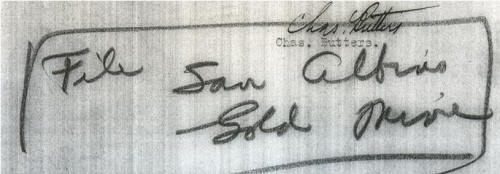
on San Albino Mine
The following
documents can be accessed as JPEG files:
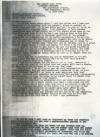 |
1.
Charles
Butters, San Francisco CA to General Augustino
Sandino [sic] via Pedro Jose Zepeda, Mexico
City, 21 June 1930, USNA127/38/30.
|
 |
(p. 2)
|
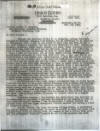 |
2.
Charles
Butters, Berkeley CA to Gen. Calvin B. Matthews,
Managua, 16 Nov. 1931.
|
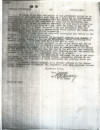 |
(p. 2).
|
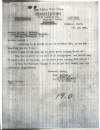 |
3.
Charles
Butters to Gen. Calvin B. Matthews, 18 Nov.
1931.
|
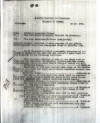 |
4.
Present
Condition of Mine Property at San Albino, GN
District Commander John Hamas to Jefe Director
GN, 22 Dec. 1931.
|
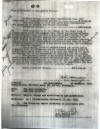 |
(p. 2).
|
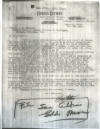 |
5.
Charles
Butters to Gen. C. B. Matthews, 16 Feb. 1932.
|
The following
photographs of the ruins of San Albino Mine,
taken in early 2007, were kindly provided by
Mr. Dan Plazak, a geologist, engineer, and author of a
fascinating history of mining scandals in the US
mining industry,
A Hole in the Ground with a
Liar at the Top, University of Utah Press,
2006. His account of finding the San
Albino Mine can be found
in an MSWord file
here. Thanks Dan!
|
|
top of page
|
|
|

